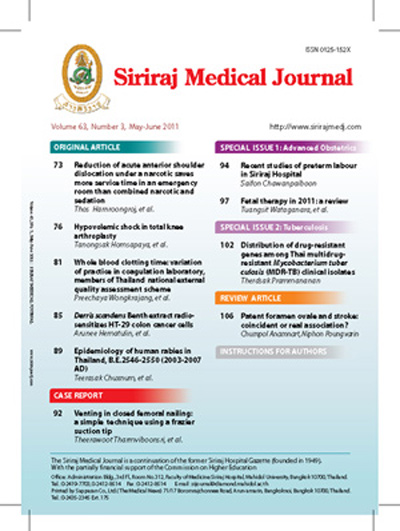Whole Blood Clotting Time: Variation of Practice in Coagulation Laboratory, Members of Thailand National External Quality Assessment Scheme
Keywords:
Whole blood clotting time; venous clotting time; WBCT; snake biteAbstract
Objective: To collect the necessary data for a perspective of Whole Blood Clotting Time (WBCT) practice in Thailand.
Methods: In March 2007, 124 questionnaires were sent to laboratory members of the Thailand National External Quality Assessment Scheme (Thailand NEQAS) to obtain essential information about the WBCT practice.
Results: From a dispatch of 124 questionnaires, 120 (96.77%) were returned. There were 101 (84.1%) hospitals performing WBCT in the laboratories and the mean number of WBCTs performed was 16.17 times/month. Eighty nine laboratories (88.11%) used the modified Lee-White methods. Seventy four laboratories (73.26%) used snake bite and other animal bites as
the indication for WBCT. Thirty three laboratories (34.37%) had problems performing the WBCT.
Conclusion: The WBCT methods among the practice of the Thailand NEQAS laboratory members were as various as problems concerning WBCT throughout Thailand. Their practice needs to be improved and standardized by proper education. It also emphasizes the need for an appropriate guidelines for WBCT in Thailand.
References
Disease control, Ministry of Public health, Thailand 2008.
2. Bureau of Medical Technical Development. Department of Medical Services
Ministry of Public Health. Practice Guideline for Management of Patients
with Snake Bite. Thailand; 2004.
3. White RILaPD. A clinical study of the coagulation time of blood. Am
J Med Sci. 1913;145:495-503.
4. Fritsma G. Clot-Based Assays of Coagulation. In: Fristma DCaG, editor.
Hemostasis and Thrombosis. Philadelphia: JB Lippincott; 1988. p. 92-127.
5. Krulder JW, van der Meer FJ, Briët E, Meinders AE. Monitoring heparin
treatment with the APTT: the effect of methodological changes on the
APTT. Neth J Med. 1996 Jul;49(1):13-8.
6. Hattersley PG. Progress report: the activated coagulation time of whole
blood (ACT). Am J Clin Pathol. 1976 Nov;66(5):899-904.
7. Goodman TL, Todd ME, Goldsmith EI. Laboratory observations and
clinical implications of monitoring the effect of heparin by bioassay. Surg
Gynecol Obstet. 1976 May;142(5):673-85.
8. Chong LL, Sussman, II, Spaet TH. Monitoring heparin therapy--a role
for the chromogenic assay. Clin Lab Haematol. 1983;5(1):61-5.
9. Brandt JT, Triplett DA. Laboratory monitoring of heparin. Effect of reagents
and instruments on the activated partial thromboplastin time. Am
J Clin Pathol. 1981 Oct;76(4 Suppl):530-7.
10. Berry BR, Nantel S. Heparin therapy: current regimens and principles
of monitoring. Postgrad Med. 1996 Jun;99(6):64-6, 9-76.
11. Mcintyre KE. Letter: Heparin, aspirin and Lee-White clotting time. Chest.
1974 Apr;65(4):475.
12. Handley AJ. Heparin therapy: a simpler test of control. J Clin Pathol.
1974 Mar;27(3):250-2.
13. Richardson AW, Bishop JG. A simple and practical method for measuring
and recording blood coagulation time. Science. 1953 Jan 9;117(3028):37-9.
14. Tsang JSC. Heparin therapy guided by modified Lee and White whole
blood clotting time on haemodialysis patients. J Hong Kong Med Assoc.
1993; 45(3):4.
15. Stuart RK, Michel A. Monitoring heparin therapy with the activated partial
thromboplastin time. Can Med Assoc J. 1971 Mar 6;104(5):385-8.
16. Mayer GA. A method for the reliable determination of clotting time in
whole blood. Can Med Assoc J. 1955 Jun 15;72(12):927-9.
17. WHO/SEARO Guidelines for the clinical management of snake bites in
the Southeast Asian region. Southeast Asian J Trop Med Public Health.
1999;30 Suppl 1:1-85.
18. Tientadakul P. Whole blood clotting time. Manual of basic laboratory tests.
Bangkok: Watcharin Press; 2000. 44 p.
19. Whole blood clotting time. In: Visudhiphan SB, Opartkiattikul N, Sangtawesin
W, editor. A Laboratory Manual of Hemostasis Bangkok: Ruen
Kaew Press; 1992. p. 25-6.
20. Meissner GF, Moehring CM. The standard clotting time. A method based
on the use of whole venous blood in capillary tubes. Tech Bull Regist
Med Technol. 1963 Feb;33:29-31.
21. Tientadakul P. Venous clotting time. In: Opartkiattikul N, Wanachiwanawin
D, Kunakorn M, Wongtiraporn W, editor. Clinical Pathology. Bangkok:
Ruen Kaew Press; 2002. p. 520-1.
22. Limpawittayakul P, Pongpit J, Juntiang J, Akkawat B, Rojnuckarin P.
Accuracy of venous clotting time(20WBCT) and Prothrombin time(PT)
compared with fibrinogen assay in green pit viper bite patients. Oral
presentation in the Annual meeting of the Royal College of Physician
of Thailand; 2553.
23. Snake bite patients. Guideline for treatment of hematology diseases in
Thailand. Intarakumthornchai T, editor. Bangkok; 2000. p. 273-80.
Downloads
Published
How to Cite
Issue
Section
License
Authors who publish with this journal agree to the following conditions:
Copyright Transfer
In submitting a manuscript, the authors acknowledge that the work will become the copyrighted property of Siriraj Medical Journal upon publication.
License
Articles are licensed under a Creative Commons Attribution-NonCommercial-NoDerivatives 4.0 International License (CC BY-NC-ND 4.0). This license allows for the sharing of the work for non-commercial purposes with proper attribution to the authors and the journal. However, it does not permit modifications or the creation of derivative works.
Sharing and Access
Authors are encouraged to share their article on their personal or institutional websites and through other non-commercial platforms. Doing so can increase readership and citations.











